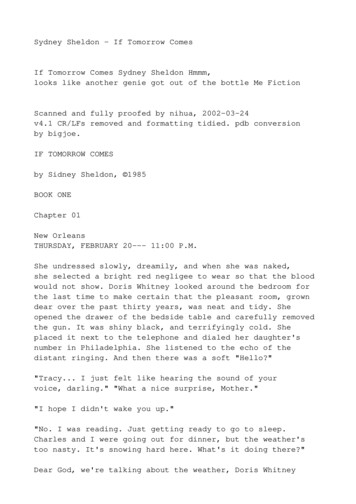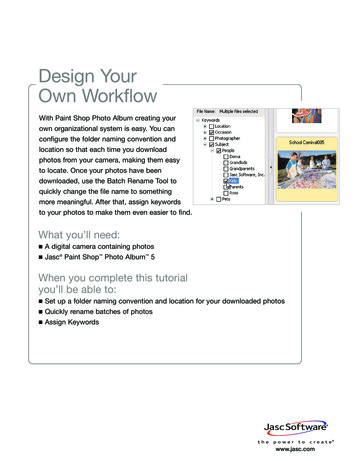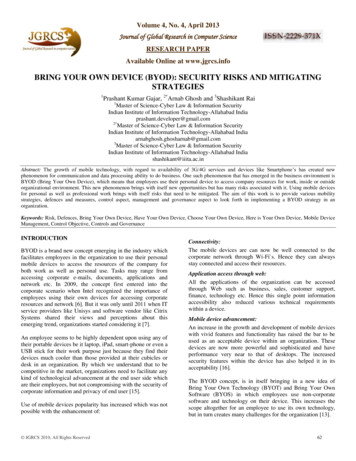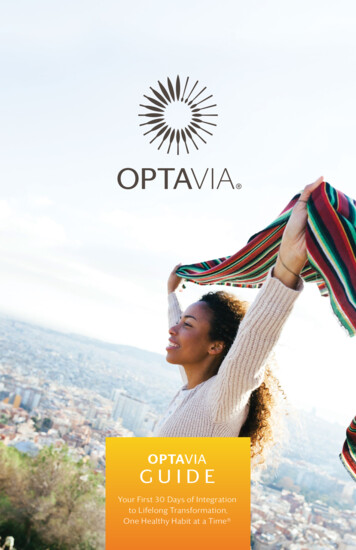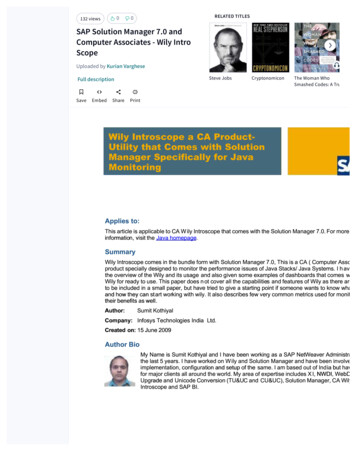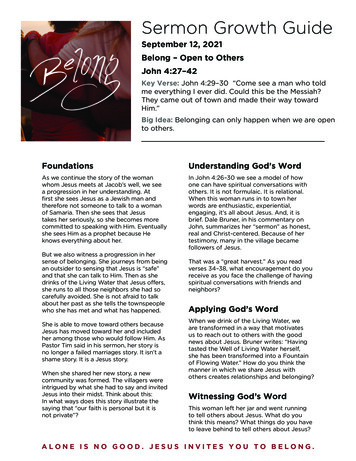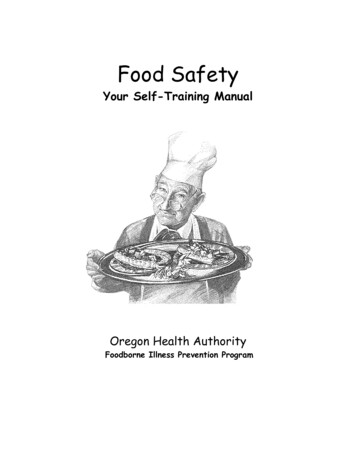
Transcription
Food SafetyYour Self-Training ManualOregon Health AuthorityFoodborne Illness Prevention Program
Why Read This Book? .1Food Handler Card.1Training Required.1Reciprocity and Equivalency .1How to Use This Book. 2A “Person in Charge” is Required . 2Keep This Book to Use as a Reference . 3Learning Objectives . 4Employee Illness . 4Handwashing. 5Your Role in Helping Prevent Foodborne Illness . 7The Role of Management . 8Foodborne Illness . 8Temperature Control . 9Final Cooking Temperature. 10Contamination and Cross Contamination. 10Your Own Health Comes First . 11Work Only When You Are Well . 11Review . 12Prevent the Spread of Disease . 13Handwashing is Very Important. 13Germs are Everywhere . 14Review . 15Employee Practices. 16How You Look and How You Act . 16Fingernails . 16Gloves can spread germs . 16Beverages . 16What Makes People Sick From Food? . 17Foodborne Illness . 17Potentially Hazardous Foods. 17Bacteria . 17Other Germs . 18Food Safety: Your Self-Training Manuali#34-83 English(Rev 07/12)
Chemicals . 18Physical Contamination . 18Food Temperatures . 19Temperature Control . 19The "Danger Zone" . 19When to Discard Food . 19Cooking Food . 19When is Cooked Food Safe? . 19Cold Holding . 20Hot Holding . 20Review . 21Safe Storage Practices. 22A Clean Workplace is Safer . 24Follow These Important Rules. 24Utensils, Surfaces and Equipment. 25Review . 26Glossary . 27Practice Test . 29Reference Section . 32Employee Illness . 33Handwashing. 34Cooking Temperatures . 35How To Use a Food Thermometer . 37Calibrating A Food Thermometer . 39Cooling Hot Foods . 40Date Marking . 43Pests. 43Food Safety: Your Self-Training Manualii#34-83 English(Rev 07/12)
Why Read This Book?FoodHandlerCardAll food handlers employed in food service mustobtain a food handler card within 30 days fromthe date of hire. As a food handler, you arerequired to keep your food handler card currentby renewing it every three years.TrainingRequiredThe goal of this program is to provide you with abasic understanding of food safety. This willassist your manager, who is responsible forensuring that you prepare and serve food safely.A food handler card confirms that you havemet the learning objectives in this book.ReciprocityandEquivalencyAny person who has a current certificate from aDepartment-approved food manager certificationprogram need not obtain a food handler card.To be accepted in place of a food handler card, afood manager certificate must be current andrenewed upon expiration.Photocopies of the food handler cards and foodmanager training certificates should be kept atthe facility to show the health inspector uponrequest.Food Safety: Your Self-Training Manual1Revised 7/12
How to usethis bookThis book is intended to help you learn what youneed to know to obtain a food handler card. Youwill need a score of 75% to pass. You will betested on all of the learning objectives that arelisted on pages (4-9). Throughout this book youwill find study questions that will help you getready to take the test for the food handler card.At the end of the book is a practice test for youto take and see how you do.The words that are italicized and bold areexplained in the glossary located in the back ofthis book.A “Personin Charge”is RequiredSomeone at your restaurant must be in chargeduring all hours of operation. This person incharge (PIC) is responsible for knowing the foodsanitation rules and the procedures within yourestablishment. This person is responsible forproviding you with information you need toperform your job.The PIC is usually a manager or supervisor, butcan be anyone who can demonstrate the knowledgelisted above, and is given the authority to overseeother employees.Food Safety: Your Self-Training Manual2Revised 7/12
Keep This Book to Use as a ReferenceThis book is yours and should be kept at hand in case you have anyquestions. If something comes up that you cannot answer withthis book, ask the “person in charge” or call your local countyhealth department for help.Phone numbers of the local health department in your kCurryDeschutesDouglasGilliamGrantHarneyHood 74-5325541-883-1122Food Safety: Your Self-Training 541-763-2725503-434-7525Revised 7/12
Food Handler TrainingLearning ObjectivesFood workers are expected to know this information to obtaintheir food handler card.The concept of foodborne illness will be introduced. The trainingwill address personal hygiene, contamination, and temperaturecontrol to reinforce the food handler's behaviors, which canprevent foodborne illness.Employee Illness1.The food handler will know to call the person in charge atthe food service facility when ill with diarrhea, vomiting,jaundice, or fever with sore throat.2.The food handler will know not to work in the food servicefacility while ill with these symptoms.3.The food handler will know to not work in food service for24 hours after symptoms of diarrhea or vomiting have gone.4.The food handler will know not to handle food with aninfected boil, cut, burn, or sore on the hand or wrist. Foodmay be handled if the injury is covered with a clean bandageand a latex-free glove.Food Safety: Your Self-Training Manual4Revised 7/12
HandwashingWorkers will understand elements of good handwashing.1.The food handler will be able to identify the correcttechnique for handwashing: Use running warm water and soap Scrub hands and rinse thoroughly (approximately 20seconds) Dry hands with single-use towel, or air dryer2.The food handler will be able to identify situations whenfood handlers must wash their hands:Before starting workAfter using the toilet and again when entering work areaAfter handling raw food and raw animal productsAfter handling dirty dishesAfter handling garbageAfter cleaning or using chemicalsAfter blowing nose, sneezing, coughing, or touching eyes,nose or mouth After smoking, or using tobacco products After eating or drinking Before putting on food service gloves 3.The food handler will know that a double handwash means tolather hands with soap and warm water for approximately20 seconds, rinse, and repeat a second time. Dry hands withpaper towels or air dryer.Food Safety: Your Self-Training Manual5Revised 7/12
4.The food handler will be able to identify situations whenfood handlers must wash their hands twice (doublehandwash): After using the toilet and again when entering work area(double handwash) After blowing nose, sneezing, coughing, or touching eyes,nose or mouth (double handwash) Before starting work (double handwash) Anytime hands come into contact with body fluids (doublehandwash) After smoking, or using tobacco products (doublehandwash) After eating or drinking (double handwash)5.The food handler will know that food service gloves arecapable of spreading germs and are not a substitute forproper handwashing.6.The food handler will know that smoking, eating, andchewing tobacco is prohibited in food preparation areas,including food and utensil storage areas.Food Safety: Your Self-Training Manual6Revised 7/12
Your Role in Helping Prevent Foodborne Illness1.The food handler will be able to describe five majormistakes that often cause foodborne illness: 2.Inadequate handwashingEmployees working while they are illCross contaminationInadequate cooking temperaturesInadequate temperature control (allowing foods to be inthe danger zone)The food handler will be able to describe the activitiesperformed by food handlers that prevent foodborne illnessfrom happening. Activities preventing foodborne illnessinclude: Proper handwashing every time hands may have becomecontaminated Food handlers working only when healthy Storing and handling of foods in a manner to preventcontamination Cooking each animal product to its required internaltemperature Maintaining hot and cold temperatures (keeping foods outof the danger zone)Food Safety: Your Self-Training Manual7Revised 7/12
The Role of Management in Helping PreventFoodborne Illness1.The food handler will know that the manager sets the toneof what food safety activities occur or don't occur withinthe facility.2.The food handler will know that the food servicemanagement is responsible for training and ensuring thatfood handlers practice activities that prevent foodborneillness.Foodborne Illness1.The food handler will be able to describe foodborne illnessas an illness resulting from eating contaminated food.2.The food handler will know that food contaminated withorganisms (germs) does not always look, smell or tastedifferent from non-contaminated food.3.The food handler will know that symptoms vary and mayinclude diarrhea, vomiting, fever, cramping and nausea.4.The food handler will know that depending on the cause,symptoms may develop in a few minutes to several days.Some symptoms may last several days and can result indeath.5.The food handler will know that foodborne illness is causedby organisms (germs), chemicals, or toxins.Food Safety: Your Self-Training Manual8Revised 7/12
Temperature ControlWorkers will understand why hot and cold holdingtemperatures are important factors in preventing illness.1.The food handler will be able to identify potentiallyhazardous foods as food that will support bacterial growthwhen held at temperatures in the danger zone.2.The food handler will be able to identify the danger zone asany temperature between 41 degrees F and 135 degrees F.3.The food handler will be able to identify that food beingcooled or heated must move through the danger zone asrapidly as possible.4.The food handler will be able to identify 135 degrees F orhotter as the proper temperature for hot holdingpotentially hazardous food.5.The food handler will be able to identify 41 degrees F orcolder as the proper temperature for cold holdingpotentially hazardous food.6.The food handler will know that you cannot make food safeto eat when food has been in the danger zone for four hoursor more.Food Safety: Your Self-Training Manual9Revised 7/12
Final Cooking TemperatureWorkers will understand why cooking foods to propertemperatures are important for preventing illness.The food handler will be able to identify that cooking foods tothe recommended temperature will kill disease-causing germs.Contamination and Cross ContaminationWorkers will understand why cross contamination is dangerousand know ways to prevent it.1.The food handler will be able to define and identify physicalcontamination as foreign objects accidentally introducedinto food. Food items may arrive already contaminated withdirt and pebbles.2.The food handler will be able to define and identify crosscontamination as happening when microorganisms aretransferred from one food or surface to another food.3.The food handler will be able to identify methods toprevent cross contamination such as washing, rinsing, andsanitizing utensils, work surfaces and equipment betweenuses.4.The food handler will be able to identify storage conditionsthat will minimize the potential for cross contamination: Store raw meats below and completely separate fromready-to-eat food in refrigeration units Store chemicals, cleansers and pesticides completelyseparate from food, utensils, and single service items Properly label all chemicals, cleansers and pesticidesFood Safety: Your Self-Training Manual10Revised 7/12
Your Own Health Comes FirstWork OnlyWhen YouAre WellIf you feel sick you should not go to work. Thegerms you bring to work can spread when youtouch food, dishes, counters, utensils, and otherpeople. Do not work if you have a fever and sore throat Do not work if you have loose bowels (diarrhea) Do not work if you are throwing up (vomiting) Do not work if you have yellowing of the skin ordark tea colored urine (jaundice)Wait for at least 24 hours after vomiting ordiarrhea have stopped before returning towork.Tell your manager if you have any of thesesymptoms. If the manager has questions, he orshe can call the County Health Department.Do not handle food with an infected boil, burn, cutor sore on your hand. Food may be handled if youcover the injury with a clean bandage, and wear alatex-free glove.Food Safety: Your Self-Training Manual11Revised 7/12
ReviewWrite your answers to the study questions in thespace provided.1. What does it mean to have a person in charge(PIC) in your facility?2. What should you do at work when you are sick?3.What are the five symptoms (if you were tohave any one of them) that you must tell yourmanager?4. You must wait 24 hours before returning towork after what symptoms have gone?Food Safety: Your Self-Training Manual12Revised 7/12
Prevent the Spread of DiseaseHandWashing isVeryImportantWash your hands often when working with foodand drinks - this gets rid of germs that can makepeople sick. Wash your hands for approximately20 seconds with warm running water and soap,and then dry them with clean paper towels, or anair dryer.Remember to always wash your hands: Before you start preparing foodBefore you touch food that will not be cookedBefore you put on latex-free gloves and afteryou remove themAfter handling raw meat, fish and poultryAfter you handle trash and take out garbageAfter you handle dirty dishesAfter cleaning or using chemicalsDouble handwash is required before startingwork, and when your hands come into contact withbody fluids. Lather hands with soap and warmwater for approximately 20 seconds, rinse, andrepeat a second time. Dry hands with paper towelor air dryer.Food Safety: Your Self-Training Manual13Revised 7/12
DoubleHandwashIt is necessary to wash your hands a secondtime: After you go to the restroom (use thetoilet) and wash hands again when you return tothe kitchen After you eat or drink an open beverage After you blow your nose, cough or sneeze,because your hands have touched your nose ormouth After smoking or using tobacco productsGerms areEverywhereGerms such as bacteria and viruses areeverywhere. Think of your hands and fingernailsas easily "contaminated." Just because they lookclean does not mean they are clean. Germs aretoo tiny to see with your eyes. If you do notwash your hands in the right way and keep yourfingernails trimmed short, your hands can putgerms in food that will be eaten by yourcustomers. They may get sick from thesegerms. This is called "foodborne illness" or"food poisoning."Gloves andHandwashingGloves and other barriers do not replacehandwashing. Wash hands before putting gloveson and when changing to a new pair.Change your gloves: As soon as they become soiled or torn Before beginning a different task After handling raw meats, fish, or poultryFood Safety: Your Self-Training Manual14Revised 7/12
ReviewWrite your answers to the study questions in thespace provided.1. What is it called when someone gets sick fromeating food contaminated with germs or toxins?2. How long must you wash your hands?3. When must you wash your hands?4. What is a double handwash?5. When must you do a double handwash?Food Safety: Your Self-Training Manual15Revised 7/12
Employee PracticesTake Careof How YouLook andHow YouActDo not smoke or chew tobacco while you areworking or when you are near food or dishwashingareas. Smoke only while you are on a break. Afteryou smoke, wash your hands before you return towork.FingernailsBe sure to scrub underneath your fingernails. Itis much easier to keep fingernails clean whenthey are kept short.Gloves canspreadgermsSingle-use food service gloves can also spreadgerms. Always wash and dry your hands beforeputting on gloves. Wash again when gloves areremoved. Change gloves between tasks. Whenyou wear gloves be aware that gloves can spreadgerms onto food that will not be cooked. Evenwhen you wear gloves, it is best to keepfingernails short.BeveragesWhen you are thirsty while working, you maydrink from a closed beverage cup with lid andstraw or cup with lid and handle. This is allowedonly if the food worker is careful to preventcontamination of hands, equipment, any serviceitems, and exposed food.Food Safety: Your Self-Training Manual16Revised 7/12
What Makes People Sick From Food?Foodborne IllnessPotentiallyHazardous Foods(Time/TemperatureControl forFood Safety)BacteriaPeople can get sick when the food they eathas germs. Germs cause foodborne illnessor food poisoning.Germs grow easily in foods like meat, fish,poultry, milk, re-fried beans, cooked rice,baked potatoes and cooked vegetables.These are called potentially hazardousfoods. These are all foods that are moistand they have nutrients that the germsneed to grow. Germs grow well on thesefoods at warm temperatures between 41oFand 135oF.Different kinds of germs can make peoplesick. Bacteria are one kind of germ. Theygrow fast and they may cause foodborneillness. Some bacteria make toxins thatact like a poison. Cooking does not destroymost toxins. Almost always, the food looksand smells good, but it may have enoughbacteria or toxin to make someone sick.Toxins can occur in many foods that havenot been kept cold enough or hot enough.Food Safety: Your Self-Training Manual17Revised 7/12
Other GermsVirusesParasitesChemicalsA virus is another kind of germ that causesillness when it gets into the food.You can have a virus and not know it. Evenbefore you start feeling sick, you may bepassing viruses into the food by not washingyour hands after coughing, sneezing or usingthe toilet. This is one reason why the lawrequires all food workers to wash their handstwice (double handwash) using lots of soapand warm water.Tiny worms that live in fish and meat are calledparasites. Cooking fish and meat to the righttemperature will kill parasites.People can also get sick when chemicals get intothe food. Be sure to keep chemicals away fromfood.PhysicalContaminationPhysical contamination is when foreign objectsare accidentally introduced into food. Fooditems may arrive already contaminated withdirt, and pebbles. Physical contamination suchas broken glass can also happen at the facility.ContaminatedFoodThe food is contaminated. Now what? Discardcontaminated food, and notify your managerright away!Food Safety: Your Self-Training Manual18Revised 7/12
Food TemperaturesTemperatureControl (forFood Safety)This section is about killing germs with cookingand stopping their growth by keeping the foodhot or cold. This is called temperature control,and your restaurant needs at least one accuratemetal-stem probe (food) thermometer to checkfood temperatures.The "DangerZone"Germs like bacteria need time, food andmoisture to grow. The temperature between41oF(5oC) and 135oF(57oC) is called the"Danger Zone!" When food sits in the "DangerZone", bacteria can grow fast and make toxinsthat can make you and others sick.When toDiscard FoodFoods left in the Danger Zone for more thanfour hours must be discarded. Reheating thefood may kill the bacteria but the toxins(produced by bacteria) will remain in theproduct and cause illness.Cooking FoodCooking raw food to the proper temperature willkill germs that cause people to become sick.When isCooked FoodSafe?Different foods have to reach differenttemperatures to be done or safe. Ask yourmanager to show you a temperature chart forcooking meats (see reference in back of thismanual). Be sure to cook the food to thetemperature that is shown on the chart.Food Safety: Your Self-Training Manual19Revised 7/12
RememberYou can choose several ways to cook food. Nomatter how you cook the food, it must reach thecorrect cooking temperature. Using a metalstem probe thermometer is the only way to knowthe correct temperature of food. You mustplace the thermometer in the thickest part ofthe meat or in the center to get a true reading.Cold HoldingAlways keep cold food at 41oF(5oC) or colder.Fish, shellfish, poultry, milk and red meat willstay fresh longer if you hold them cold at41oF(5oC) or colder.Hot HoldingAfter the food is cooked and ready to serve,you will need to keep it warm enough to stop anygerms from growing. You must turn on steamtables, soup warmers and heated surfacesbefore you need them so that they will be hotenough when you put the cooked food into them.Keep hot food at 135oF(57oC) or hotter.Keep it HotStir food to help keep the food on top hot. Acover on the pan helps to keep the heat inside.Keep it ColdFood being held cold on the top section of arefrigerated preparation unit also benefits frombeing covered.Food Safety: Your Self-Training Manual20Revised 7/12
Review1. What is the temperature for holding foodhot?2. What is the temperature for holding foodcold?3. What are some ways to help keep food hot?4. Why use a metal-stem probe thermometer?Food Safety: Your Self-Training Manual21Revised 7/12
Safe Storage PracticesYou want all the food you use to be healthy andsafe. This section talks about how to safelystore and handle food.CrossContaminationCross contamination happens when germs fromKeep FoodsSafe FromContaminationAs a food handler you must prevent crosscontamination. Here are some important waysthat you can prevent cross contamination.raw or unclean food get into foods that areready to serve or that will not be cooked againbefore you serve them.Store raw meat, fish and poultry on the lowershelves of the refrigerator.Don't let raw meats; beef, pork, lamb, fish orpoultry drip onto foods that will not be cookedbefore serving.Keep different types of raw meat separatefrom each other.Store unwashed food or raw food away fromready-to-eat food.Wash your hands between handling raw meatand foods that will not be cooked beforeeating.Food Safety: Your Self-Training Manual22Revised 7/12
Keep FoodsSafe fromContaminationNever store foods that will not be cookedbefore serving in the same container as rawmeat, fish or poultry.Wash your hands before working with foodand before wearing gloves.Use utensils or disposable gloves to workwith ready-to-eat food.Wash, rinse and sanitize the cuttingsurface and all the utensils and knivesevery time you finish with a job or betweenpreparing different foods.Use clean utensils instead of hands fordispensing food.Store foods away from cleaners and poisons.Food Safety: Your Self-Training Manual23Revised 7/12
A Clean Workplace is SaferIt takes more than soap and water to keep afood business clean and safe. You will likely beusing detergents and sanitizers.Follow TheseImportantRules Know what the directions say for usingchemicals. Read the labels and talk to yourmanager about when to use them and howmuch to use. Be sure you understand andfollow the directions! Keep chemicals away from food and cleanutensils. If chemicals must be stored inthe same room, be sure they are stored intheir own area. The area should be belowfood and utensils, so there is no chance ofchemicals splashing onto the food andutensils. Can you read the labels? Are they easy tosee? If they are not, ask your manager tore-label them so that everyone can readthem. Keep all chemicals in the bottles or boxesthey come in. If you put them in adifferent container, label them clearly.Food Safety: Your Self-Training Manual24Revised 7/12
Utensils,Surfaces andEquipmentAnother way to prevent cross contamination isto be sure that utensils, work surfaces andequipment are washed, rinsed, and sanitizedbetween uses. Wash them in hot soapy water Rinse them in clean hot water Sanitize them with freshly preparedsanitizer (1 to 2 teaspoons of bleach per 1gallon of water)DirectionsFollow the cleaning directions for each piece ofequipment.RememberThe correct steps for cleaning utensils, foodcontact surfaces and equipment are:1. Wash2. Rinse3. SanitizeFood Safety: Your Self-Training Manual25Revised 7/12
ReviewWrite your answers to the study questions inthe space provided.1. Where should you store chemicals in relationto food?2. Where in the refrigerator should you storeraw meat?3. What is cross contamination?4. What are two ways to prevent crosscontamination?1.2.5. What should you do if food becomescontaminated?Food Safety: Your Self-Training Manual26Revised 7/12
GlossaryBacteria – Bacteria are germs with only one cell that can multiplyinto large numbers when food is in the danger zone for more than4 hours.Chemicals – In this book, chemicals are referred to asingredients in cleaning, sanitizing, or pesticide products thatmake people sick if eaten.Cold Holding – Cold holding is when you keep food cold by usingrefrigeration or ice.Cross Contamination – When germs from one food item arepassed to another food item, usually raw food to ready-to-eatfood.Danger Zone – The Danger Zone is when the temperature offood is between 41oF(5 oC) and 135oF(57 oC). This is called thedanger zone because bacteria will grow quickly between thesetemperatures.Foodborne Illness- Sickness caused from germs or toxins infood. This is also called food poisoning.Food Thermometer - A metal-stem probe thermometer used totake temperatures of food.Hot holding – Holding food hot after it has been properly cookedor reheated. Food must
All food handlers employed in food service must obtain a food handler card within 30 days from the date of hire. As a food handler, you are required to keep your food handler card current
